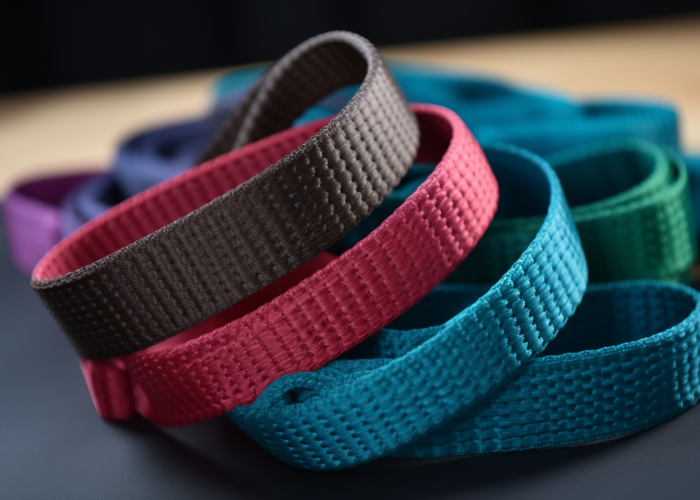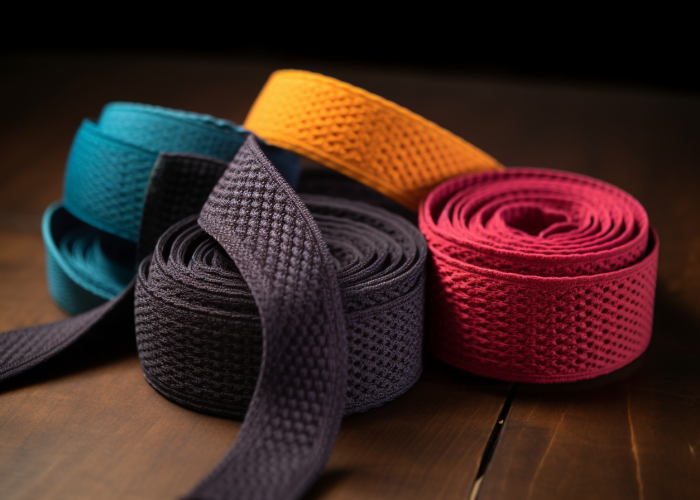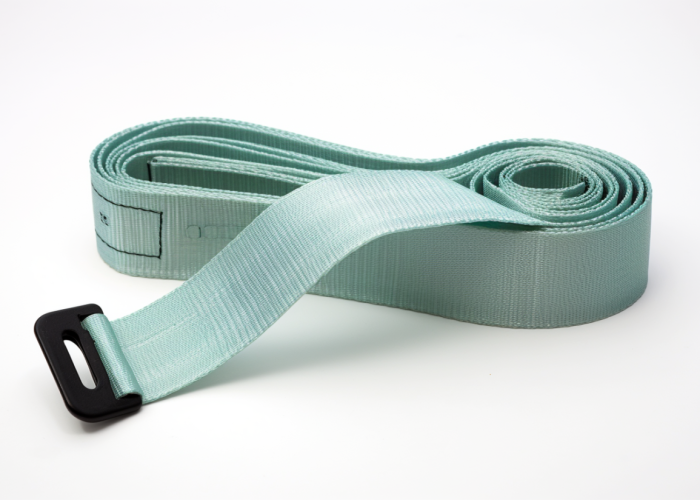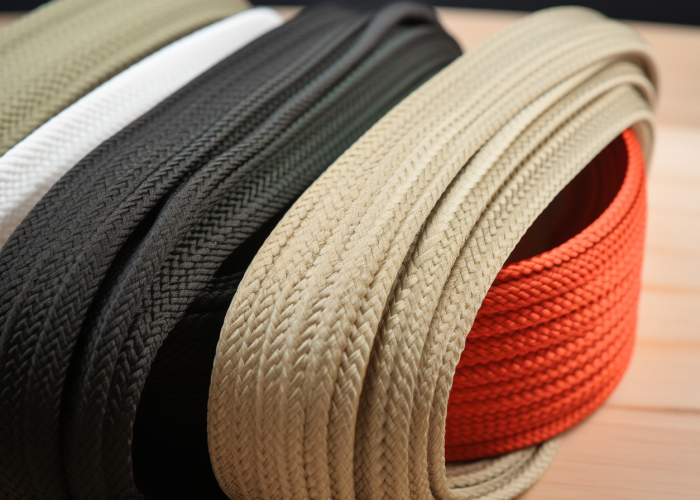Webbing that looks vibrant in sampling often fades fast outdoors. Many “UV-resistant” claims fail because the color was only surface-dyed.
Yes — solution-dyed webbing resists UV far better because pigment is built inside the fiber before extrusion, not applied afterward. This prevents sunlight from breaking pigment bonds and keeps both color and strength stable for seasons longer.
Read on to see how dyeing method, base polymer, and environment affect long-term durability — and how to specify UV-stable webbing correctly in your next RFQ.


Webbing manufacturing expert with 15+ years of experience helping product developers build high-performance straps for industrial, medical, and outdoor use.
Yes — solution-dyed webbing holds color far longer because pigment is built into the fiber during extrusion, not applied as a surface dye. UV and abrasion can strip surface color from piece-dyed yarns; embedded pigment keeps appearance stable over extended outdoor use.
You asked for “UV-resistant polyester,” the quote came back lower than expected, and the first season faded. That’s classic piece-dyed substitution—it passes initial checks but loses color as UV erodes the outer dye layer and exposes pale cores.
Solution-dyed yarns color the entire cross-section, so even after scuffing and sun, there’s no lighter interior to show through. It’s the simplest way to stop the “one-season fade” seen in outdoor gear, furniture straps, and signage.
Sourcing Tip: In your RFQ, add: “Solution-dyed yarns required (no surface/piece dye). State dyeing method on C of C.” This blocks cheaper substitutions and aligns quotes to true UV performance.
Yes — UV slowly reduces tensile strength in all synthetics, but degradation accelerates when color or protective layers sit only on the surface. Solution-dyed yarns distribute pigment throughout the fiber, reducing surface crack initiation and slowing strength loss.
If you’ve seen straps still “looking okay” yet failing early in load tests, it’s often UV-embrittlement starting at the surface on piece-dyed or coated webbings. Micro-cracks propagate under tension, cutting retained strength sooner than expected.
With solution-dyed yarns (and, where required, UV stabilizers), the fiber shares UV load through its thickness, improving retained strength consistency in continuous-sunlight applications like marine tie-downs, awnings, and outdoor fixtures.
Design Takeaway: For year-round sun, specify: “Solution-dyed yarns; UV-stabilized polymer where applicable; quote retained-strength after UV exposure or provide prior test data.” This makes strength expectations explicit and comparable across suppliers.

In most outdoor uses, solution-dyed webbing keeps its color and strength two to five times longer than surface-dyed alternatives. Accelerated UV-A tests show under 10 % color loss after 500 hours for solution-dyed polyester, versus roughly 40 – 50 % for piece-dyed yarns.
The “first-season fade” that frustrates so many buyers happens because pigment sits only on the surface. When pigment is embedded through the fiber, UV energy spreads evenly and fading tracks the polymer’s natural aging, not dye breakdown. If you’ve already seen a batch fade early, send a quick photo or small sample—lab checks can confirm in 24 hours whether it was truly solution-dyed or just coated yarn.
Polyester remains the most UV-resistant, nylon follows, and polypropylene needs stabilizers for multi-year exposure. Some outdoor OEMs switched to solution-dyed polyester after field failures and extended usable life beyond 30 months without coatings or lamination.
Design Takeaway: In your RFQ, ask suppliers to declare dyeing method, polymer, and stabilizer use, supported by retained-strength or color-shift data.
Send a small sample or photo — we’ll confirm pigment depth and polymer type within one business day.
Yes — but the usable palette depends on which pigments survive extrusion and sunlight. Bright neons, metallics, and very light pastels rarely reach full vibrancy in UV-stable form, while mid-tone and primary hues stay truest over time.
Many design teams unknowingly approve piece-dyed substitutes just to hit a color target. One way to prevent this is to share your Pantone early; we can quickly verify whether that pigment tolerates fiber-extrusion heat and suggest the closest long-life match before sampling. That simple check often avoids weeks of trial-and-error and keeps your sampling costs under control.
Anchoring the base webbing in a solution-dyed color family also ensures consistent supply; visual accents can always be added later through printing, jacquard, or trim components.
Sourcing Tip: Write into your RFQ: “Match to solution-dyed color family first; piece-dyed acceptable only for low-exposure trim. Declare dyeing method on C of C.”
Solution-dyed webbing typically runs 10 – 20 % higher in unit price, mainly from pigment compounding and smaller batch flexibility. The premium looks obvious on paper, yet once you account for fade-related rework, replacements, and warranty service, the total cost gap often flips. That’s why experienced buyers treat unit price as only one variable in total program cost.
When quotes differ widely, the lowest number is usually the piece-dyed option disguised as “UV-treated.” Suppliers can price it low because surface dyeing allows faster color changeovers and lower setup costs. It looks identical on day one — until outdoor exposure reveals the lighter core. We routinely check quote sets for customers and flag these substitutions early; if you’re reviewing multiple bids, share them for a quick look, we can tell in minutes which one hides the short-term dyeing method.
For applications under full sun — marine straps, architectural shade textiles, or outdoor furniture — lifecycle math becomes clear. Even with that 15 % price bump, solution-dyed runs generally extend usable life by two or three seasons, cutting replacement volume 40 – 60 %. In one furniture program, the team invested about 12 % more per meter yet halved field returns the first season.
Design Takeaway: When evaluating webbing bids, ask every supplier to list dyeing method, expected UV lifespan, and colorfastness data, not just price per meter. Comparing those three lines tells you the real cost-to-durability ratio before you commit tooling or packaging budgets.

Yes — UV stability differs sharply by polymer chemistry. Even with the same dyeing method, each polymer absorbs sunlight differently, so “UV-treated” means little without knowing the base material.
Polyester lasts longest because its aromatic backbone dissipates UV energy before the chains break. Nylon starts strong but weakens once heat and humidity join the exposure, while polypropylene, though cheapest, oxidizes fastest unless loaded with stabilizers.
If your current quote just says “UV-treated webbing” and leaves polymer blank, treat that as a red flag. We regularly test sample rolls for clients in ten-minute density and tensile checks and find cheaper nylon or PP standing in for polyester. Catching that early saves a full sampling cycle.
Sourcing Tip: Always require suppliers to list polymer type, dyeing method, and 500-hour UV-retention data. That single line distinguishes material science from marketing talk.
(Once the polymer is right, the next limiter is the environment it faces — and that’s where many good materials still fail.)
The same webbing behaves differently under different skies. UV, humidity, salt, and temperature each attack the fiber in their own way.
High-altitude sun burns through stabilizers faster than coastal haze; marine air reflects heat and salt that accelerate oxidation; humid tropics trigger hydrolysis in nylon. We’ve seen straps that lasted three years inland but cracked in ten months at sea level — the polymer wasn’t wrong, the stabilizer package was.
Every week spent re-sampling after an environmental failure costs a full prototype round. When you outline exposure details up front — hours of sunlight, temperature range, salt or chemical contact — we can adjust polymer blend and UV-additive ratio before you cut new tooling. One short note about “continuous outdoor use, coastal, high humidity” tells capable shops exactly how to engineer your yarn.
Design Takeaway: Add an environment & exposure line to your RFQ. It shortens quoting time and prevents the “looks fine indoors, fails outside” loop that delays launches.
Clear specification equals faster, more accurate quotes. Vague requests like “UV-resistant polyester” lead to guesswork, substitutions, and weeks of clarification emails.
A strong RFQ spells out:
We often receive draft RFQs mid-project from teams whose suppliers replied “not manufacturable.” A five-minute review usually exposes missing details or unrealistic tolerances. Forwarding that RFQ early can save a week of back-and-forth and ensure all suppliers quote the same spec.
Sourcing Tip: Copy the checklist above into your template — it’s a proven way to remove ambiguity, accelerate quotes, and reveal which shops actually understand UV webbing performance.

Piece-dyed webbing still has its role — just not where UV or long-term exposure decides performance.
For indoor, short-term, or fashion uses where cost and color flexibility outweigh durability, piece-dyed remains the fastest and most economical route.
If you’re building straps for trade-show displays, interior fixtures, or seasonal runs lasting under six months, piece-dyed makes sense. It offers near-limitless color choice and quick turnarounds — often dyed to spec within days. That’s why many design teams start here for prototyping or color approval before moving to production materials.
The trouble begins when that temporary batch goes straight into outdoor use. Within weeks, surface pigments fade and the re-order cycle starts — costing four to six weeks of downtime while replacement stock runs. We helped an outdoor-display brand avoid exactly that: they prototyped with piece-dyed, then switched to solution-dyed within three days of color sign-off, eliminating the typical resampling delay.
If you’re unsure which method fits your exposure window or delivery target, send your project timeline and environment notes. A five-minute review is usually enough to decide whether piece-dyed’s speed outweighs solution-dyed’s longevity.
Sourcing Tip: Use piece-dyed only for controlled environments or short-term displays. For outdoor or customer-facing products, switch to solution-dyed early to avoid warranty claims, re-orders, and lost production time.
Solution-dyed webbing consistently outperforms piece-dyed in UV stability, lifecycle cost, and long-term appearance. By clarifying polymer type, exposure conditions, and dyeing method early in your RFQ, you eliminate hidden risks and quote delays. If you’re unsure which approach fits your project, send your specs—we’ll help verify before production begins.
Yes, but much slower than piece-dyed. Color loss typically stays under 10 % after 500 h UV-A exposure, depending on pigment and stabilizer package. Severe fading usually points to incorrect polymer or surface-coated yarns mis-sold as solution-dyed, not failure of the process itself.
No significant difference. The pigment disperses uniformly within the polymer before extrusion, so tensile and elongation remain nearly identical to undyed yarn. In fact, eliminating post-dye heating can slightly reduce shrinkage and thermal stress, improving dimensional stability in precision assemblies.
No. Solution dyeing works with polyester, nylon, and polypropylene, but polyester is most common because it tolerates extrusion heat (≈290 °C) and resists UV breakdown best. Nylon can also be solution-dyed but needs more stabilizers, while polypropylene limits available pigment choices due to its lower melt point (~170 °C).
Not exactly. Recycled PET (rPET) can match virgin performance only when stabilizers and masterbatch ratios are adjusted for molecular degradation from prior cycles. Many suppliers skip this step. Always ask for UV-A test data (≥500 h) if using solution-dyed rPET in outdoor applications.
Cut through a strand — the color should be identical throughout the cross-section. Piece-dyed yarns show a lighter or white core. For full verification, a lab can perform solvent extraction or microscopy in under 24 h to confirm pigment distribution. We routinely run this check for buyers before production.
Generally no. The embedded pigment provides UV defense internally. Additional coatings add surface gloss or dirt resistance, not core UV protection. However, in extreme sun or marine use, pairing solution-dyed polyester with a clear polyurethane topcoat can extend visual life beyond three years.